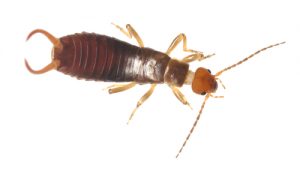What Good Are Earwigs?
By Chris Williams on November 8, 2011.
Q. Okay, I know earwigs don’t actually get in your ears, but what do they do? What’s their purpose in life? And why do they end up in my laundry room?
A. Earwigs actually are beneficial insects, most of the time. They’re part of a large group of creatures that are sanitary engineers; they help clean up the environment by feeding on decaying plant material and live and dead insects. Along with other scavengers like millipedes, pillbugs, and sowbugs, earwigs help to break down dying plant material. They may not be beneficial, though, if you own a greenhouse or are trying to grow vegetable seedlings. In large numbers, earwigs can damage living plants and can be greenhouse pests. Outside, they are found primarily in mulch and decaying leaves, or hidden in cool places under boards, rocks, or logs. Earwigs hide during the day and feed at night.
Earwigs are unusual among insects in that the female exhibits maternal care. When she is ready to lay her eggs, she drives the male out of the underground nest. She cleans and moves her eggs around in the nest so they don’t get moldy and guards them from other earwigs. She also cares for and feeds the newly hatched young in the nest until they are able to fend for themselves.
 Earwigs have a pair of formidable-looking pincers at the rear of their abdomen that are used mostly during mating. You can tell a male earwig by forceps that are curved, while on the female the forceps are straight-sided. Earwigs can pinch if provoked but that happens rarely. They don’t bite. Earwigs have very short wings but are not good fliers. To fly, they must glide from a high point.
Earwigs have a pair of formidable-looking pincers at the rear of their abdomen that are used mostly during mating. You can tell a male earwig by forceps that are curved, while on the female the forceps are straight-sided. Earwigs can pinch if provoked but that happens rarely. They don’t bite. Earwigs have very short wings but are not good fliers. To fly, they must glide from a high point.
Although they are not really indoor pests, earwigs do sometimes find their way inside. They can be accidentally carried in on plants, firewood, or newspapers that have been outside. They are attracted to lights and may get inside through doors and windows. They also sometimes migrate indoors during hot, dry periods looking for moisture. Once indoors, they hide in cracks and crevices and scavenge at night for food scraps, live or dead insects, mold, or plants.
Since earwigs need a high level of moisture, they tend to gravitate to areas of the structure that are damp like a crawlspace. That’s why they end up in your laundry room. The good news is that they don’t usually move indoors in large numbers (unless you have a large outdoor population), and those that do make it in don’t survive long inside due to the drier indoor air.
You can keep earwigs out by pest-proofing around doors and windows, drying out damp areas inside, reducing outside lighting, and by having a pest control company apply an outside perimeter treatment around your home. Cleaning up earwig habitat like mulch, leaf debris, and stacked wood or stones around the foundation will help, too.